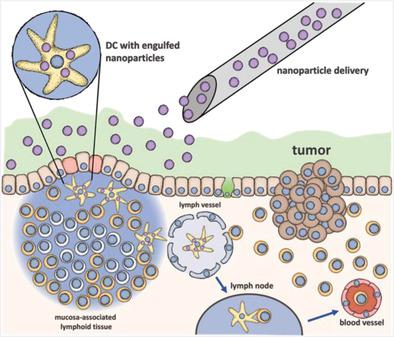当前位置:
X-MOL 学术
›
Adv. Mater.
›
论文详情
Our official English website, www.x-mol.net, welcomes your feedback! (Note: you will need to create a separate account there.)
Immunology-Guided Biomaterial's Design as Mucosal Cancer Vaccine.
Advanced Materials ( IF 29.4 ) Pub Date : 2019-12-13 , DOI: 10.1002/adma.201903847 Shiran Ferber 1, 2 , Rodrigo J Gonzalez 3 , Alexander M Cryer 1, 2 , Ulrich H von Andrian 3, 4 , Natalie Artzi 1, 2, 5, 6
Advanced Materials ( IF 29.4 ) Pub Date : 2019-12-13 , DOI: 10.1002/adma.201903847 Shiran Ferber 1, 2 , Rodrigo J Gonzalez 3 , Alexander M Cryer 1, 2 , Ulrich H von Andrian 3, 4 , Natalie Artzi 1, 2, 5, 6
Affiliation

|
Cancer of mucosal tissues is a major cause of worldwide mortality for which only palliative treatments are available for patients with late-stage disease. Engineered cancer vaccines offer a promising approach for inducing antitumor immunity. The route of vaccination plays a major role in dictating the migratory pattern of lymphocytes, and thus vaccine efficacy in mucosal tissues. Parenteral immunization, specifically subcutaneous and intramuscular, is the most common vaccination route. However, this induces marginal mucosal protection in the absence of tissue-specific imprinting signals. To circumvent this, the mucosal route can be utilized, however degradative mucosal barriers must be overcome. Hence, vaccine administration route and selection of materials able to surmount transport barriers are important considerations in mucosal cancer vaccine design. Here, an overview of mucosal immunity in the context of cancer and mucosal cancer clinical trials is provided. Key considerations are described regarding the design of biomaterial-based vaccines that will afford antitumor immune protection at mucosal surfaces, despite limited knowledge surrounding mucosal vaccination, particularly aided by biomaterials and mechanistic immune-material interactions. Finally, an outlook is given of how future biomaterial-based mucosal cancer vaccines will be shaped by new discoveries in mucosal vaccinology, tumor immunology, immuno-therapeutic screens, and material-immune system interplay.
中文翻译:

免疫学指导的生物材料作为粘膜癌疫苗的设计。
粘膜组织癌是全世界死亡的主要原因,对于晚期疾病的患者,只有姑息治疗才可用。工程癌症疫苗为诱导抗肿瘤免疫提供了一种有前途的方法。疫苗接种途径在决定淋巴细胞的迁移方式以及因此在粘膜组织中的疫苗效力中起着重要作用。肠胃外免疫,特别是皮下和肌内免疫,是最常见的疫苗接种途径。但是,这会在没有组织特异性印迹信号的情况下诱导边缘性粘膜保护。为了避免这种情况,可以使用粘膜途径,但是必须克服降解性的粘膜屏障。因此,疫苗的给药途径和能够克服运输障碍的材料的选择是粘膜癌疫苗设计中的重要考虑因素。在此,概述了在癌症和粘膜癌临床试验中的粘膜免疫力。描述了有关基于生物材料的疫苗设计的主要注意事项,尽管围绕粘膜疫苗的知识有限,特别是在生物材料和机械免疫材料相互作用的帮助下,该材料将在粘膜表面提供抗肿瘤免疫保护。最后,展望了未来的基于生物材料的粘膜癌疫苗将如何通过粘膜疫苗学,肿瘤免疫学,免疫治疗筛查和材料-免疫系统相互作用的新发现而形成。提供了在癌症和粘膜癌临床试验中的粘膜免疫的概述。描述了有关基于生物材料的疫苗设计的主要注意事项,尽管围绕粘膜疫苗的知识有限,特别是在生物材料和机械免疫材料相互作用的帮助下,该材料将在粘膜表面提供抗肿瘤免疫保护。最后,展望了未来的基于生物材料的粘膜癌疫苗将如何通过粘膜疫苗学,肿瘤免疫学,免疫治疗筛查和材料-免疫系统相互作用的新发现而形成。提供了在癌症和粘膜癌临床试验中的粘膜免疫的概述。描述了有关基于生物材料的疫苗设计的主要注意事项,尽管围绕粘膜疫苗的知识有限,特别是在生物材料和机械免疫材料相互作用的帮助下,该材料将在粘膜表面提供抗肿瘤免疫保护。最后,展望了未来的基于生物材料的粘膜癌疫苗将如何通过粘膜疫苗学,肿瘤免疫学,免疫治疗筛查和材料-免疫系统相互作用的新发现而形成。尽管关于粘膜疫苗接种的知识有限,尤其是在生物材料和机械免疫材料相互作用的帮助下。最后,展望了未来的基于生物材料的粘膜癌疫苗将如何通过粘膜疫苗学,肿瘤免疫学,免疫治疗筛查和材料-免疫系统相互作用的新发现而形成。尽管关于粘膜疫苗接种的知识有限,尤其是在生物材料和机械免疫材料相互作用的帮助下。最后,展望了未来的基于生物材料的粘膜癌疫苗将如何通过粘膜疫苗学,肿瘤免疫学,免疫治疗筛查和材料-免疫系统相互作用的新发现而形成。
更新日期:2020-04-01
中文翻译:

免疫学指导的生物材料作为粘膜癌疫苗的设计。
粘膜组织癌是全世界死亡的主要原因,对于晚期疾病的患者,只有姑息治疗才可用。工程癌症疫苗为诱导抗肿瘤免疫提供了一种有前途的方法。疫苗接种途径在决定淋巴细胞的迁移方式以及因此在粘膜组织中的疫苗效力中起着重要作用。肠胃外免疫,特别是皮下和肌内免疫,是最常见的疫苗接种途径。但是,这会在没有组织特异性印迹信号的情况下诱导边缘性粘膜保护。为了避免这种情况,可以使用粘膜途径,但是必须克服降解性的粘膜屏障。因此,疫苗的给药途径和能够克服运输障碍的材料的选择是粘膜癌疫苗设计中的重要考虑因素。在此,概述了在癌症和粘膜癌临床试验中的粘膜免疫力。描述了有关基于生物材料的疫苗设计的主要注意事项,尽管围绕粘膜疫苗的知识有限,特别是在生物材料和机械免疫材料相互作用的帮助下,该材料将在粘膜表面提供抗肿瘤免疫保护。最后,展望了未来的基于生物材料的粘膜癌疫苗将如何通过粘膜疫苗学,肿瘤免疫学,免疫治疗筛查和材料-免疫系统相互作用的新发现而形成。提供了在癌症和粘膜癌临床试验中的粘膜免疫的概述。描述了有关基于生物材料的疫苗设计的主要注意事项,尽管围绕粘膜疫苗的知识有限,特别是在生物材料和机械免疫材料相互作用的帮助下,该材料将在粘膜表面提供抗肿瘤免疫保护。最后,展望了未来的基于生物材料的粘膜癌疫苗将如何通过粘膜疫苗学,肿瘤免疫学,免疫治疗筛查和材料-免疫系统相互作用的新发现而形成。提供了在癌症和粘膜癌临床试验中的粘膜免疫的概述。描述了有关基于生物材料的疫苗设计的主要注意事项,尽管围绕粘膜疫苗的知识有限,特别是在生物材料和机械免疫材料相互作用的帮助下,该材料将在粘膜表面提供抗肿瘤免疫保护。最后,展望了未来的基于生物材料的粘膜癌疫苗将如何通过粘膜疫苗学,肿瘤免疫学,免疫治疗筛查和材料-免疫系统相互作用的新发现而形成。尽管关于粘膜疫苗接种的知识有限,尤其是在生物材料和机械免疫材料相互作用的帮助下。最后,展望了未来的基于生物材料的粘膜癌疫苗将如何通过粘膜疫苗学,肿瘤免疫学,免疫治疗筛查和材料-免疫系统相互作用的新发现而形成。尽管关于粘膜疫苗接种的知识有限,尤其是在生物材料和机械免疫材料相互作用的帮助下。最后,展望了未来的基于生物材料的粘膜癌疫苗将如何通过粘膜疫苗学,肿瘤免疫学,免疫治疗筛查和材料-免疫系统相互作用的新发现而形成。



























 京公网安备 11010802027423号
京公网安备 11010802027423号